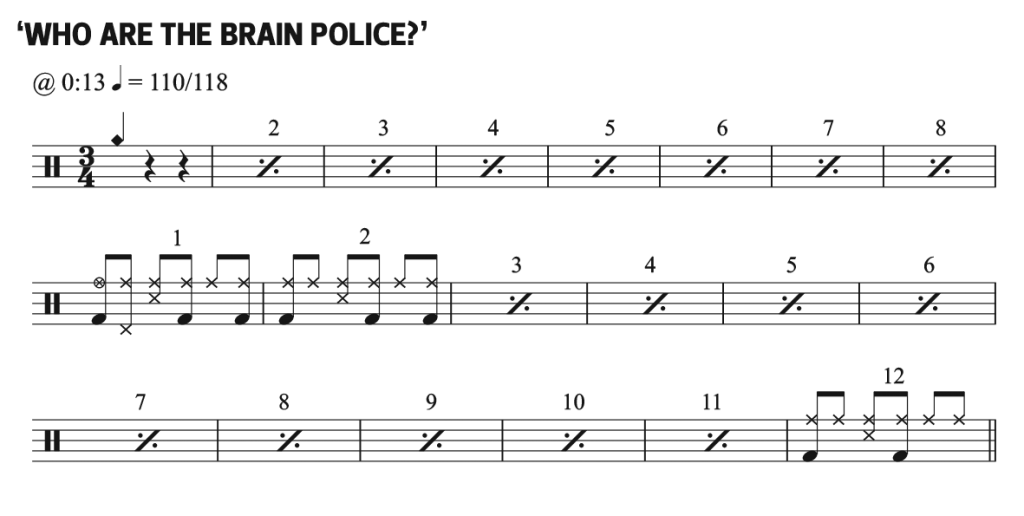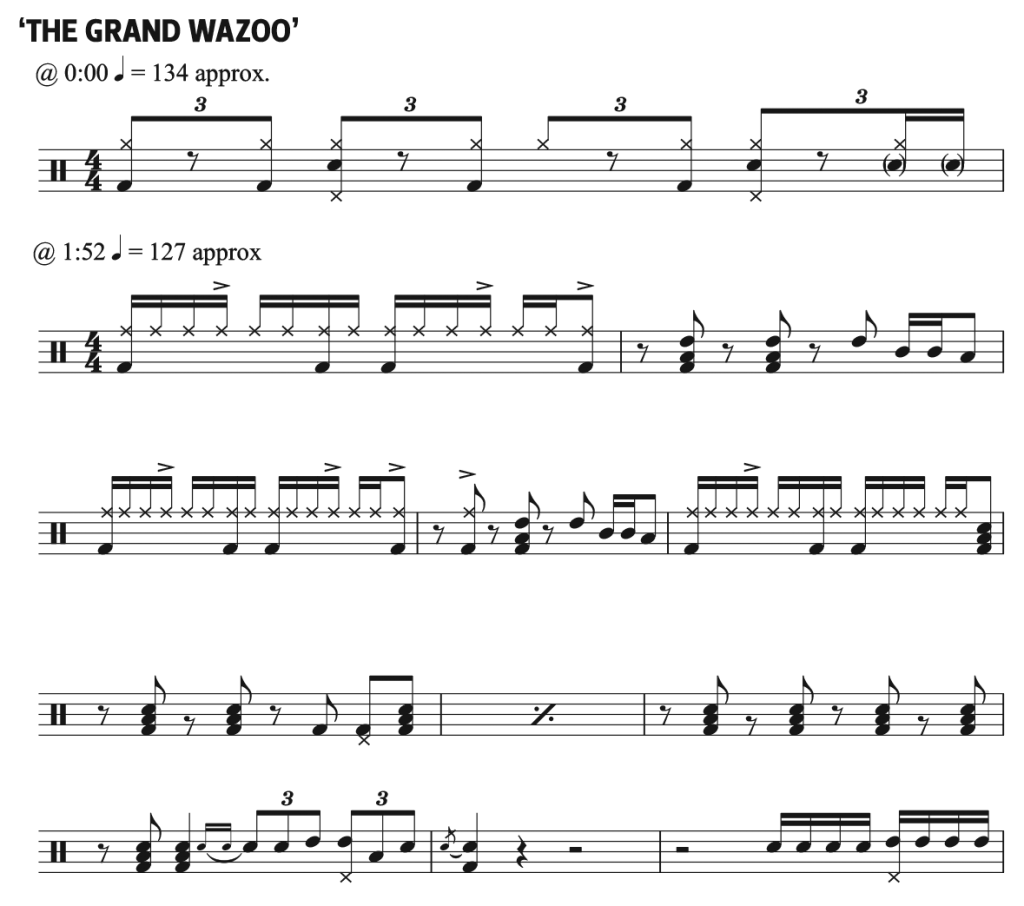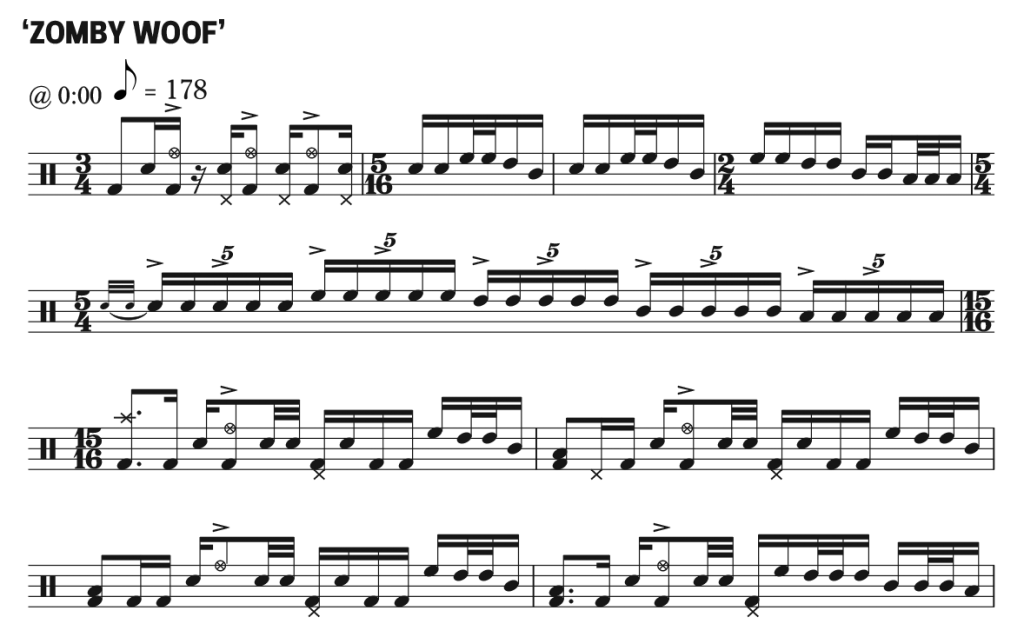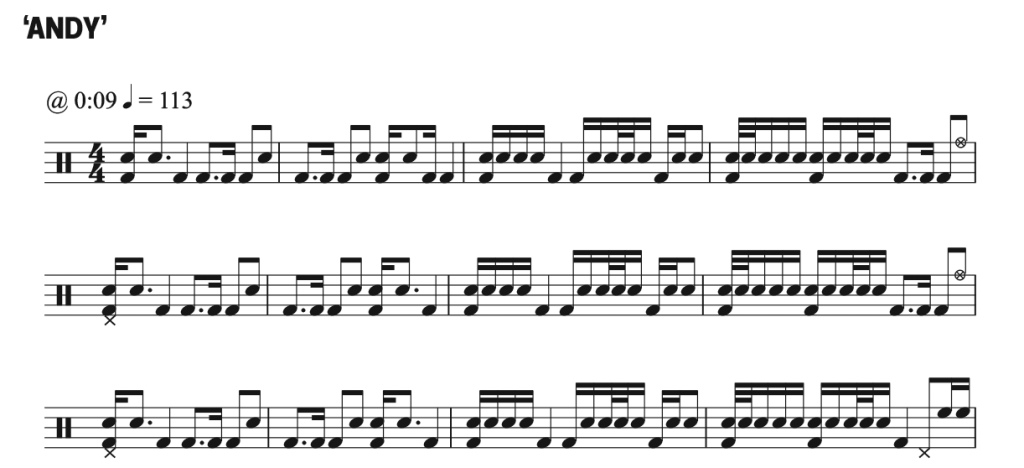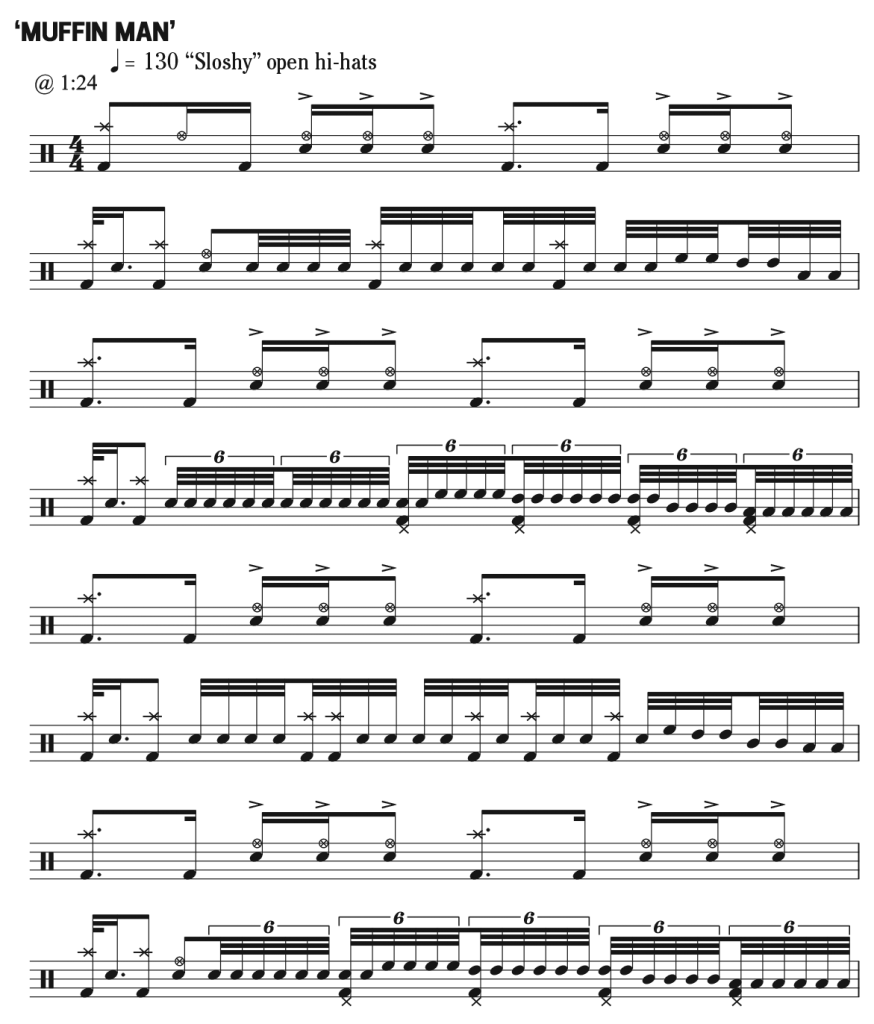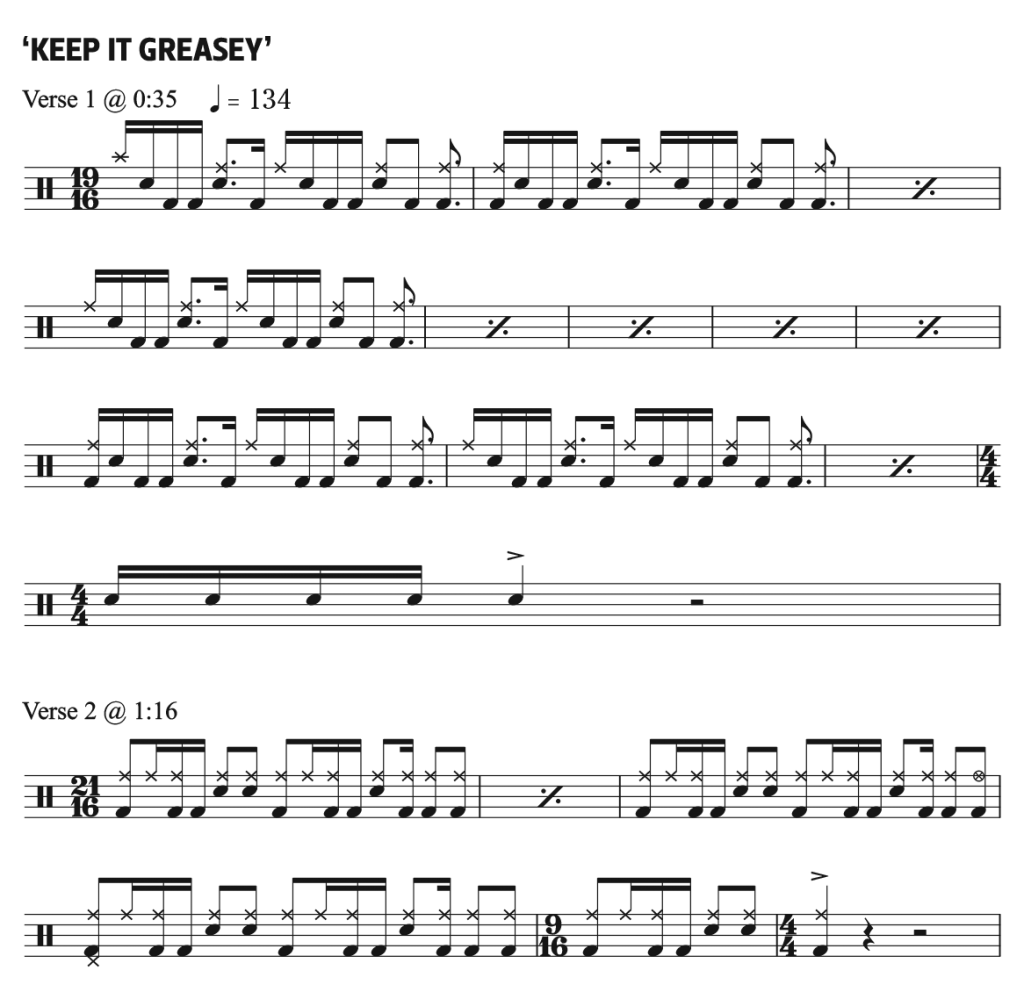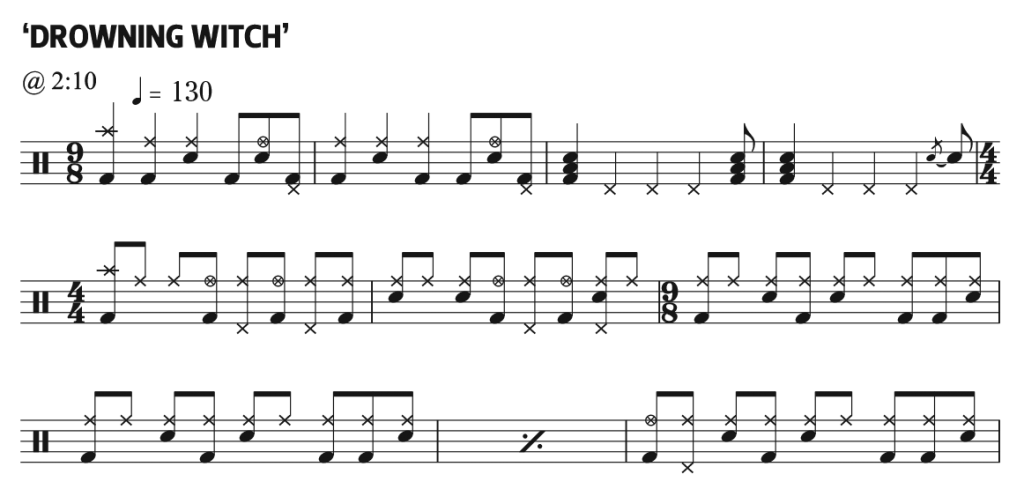BY RYAN BROWN | FROM THE FALL 2018 ISSUE OF DRUM!
For the past five years, Ryan Brown has toured with Dweezil Zappa in the fantastic tribute act to Frank Zappa. He not only performs faithful recreations of the drum parts of some of the greatest drummers ever to pick up a pair of sticks, but takes extra care to capture the style and feeling of that each artist. Here, he breaks down the drum parts to some of Frank’s more popular tunes.
“Ryan Brown, in any show, has to play parts that were played by Terry Bozzio or Chad Wackerman or Vinnie Colaiuta or any of the drummers that played with my dad, and they all have a certain personality to them.”
— Dweezil Zappa
‘WHO ARE THE BRAIN POLICE?’
ALBUM: FREAK OUT!, 1966
DRUMMER: Jimmy Carl Black
“Who Are The Brain Police?” illustrates Frank Zappa’s love of the number three. The time signature is 3/4. When the verse lyrics come in, it is a 12-bar phrase that is divided into four three-bar phrases. Many songs in his catalog include sections that have three-bar phrases. Chronologically, this song is the first odd-meter song on Frank’s first album.
‘THE GRAND WAZOO’
ALBUM: THE GRAND WAZOO, 1972
DRUMMER: Aynsley Dunbar
Frank wrote many shuffles, as he was heavily influenced by early R&B and doo-wop. This tune starts out with an extended guitar solo before the head of the song comes in. Practice this one-bar example of the groove, then add ghost notes and small fills to the pattern like Aynsley Dunbar does. The section at 1:52 has a sixteenth-note feel, even though the tune is a shuffle. I’ve always loved this contrast. Note how you can hear Dunbar keeping time with his left foot hi-hat very lightly through some of the figures, then the fill leading back into the shuffle is sixteenth-notes — not a typical way to set up a shuffle!
‘ZOMBY WOOF’
ALBUM: OVER-NITE SENSATION, 1973
DRUMMER: Ralph Humphrey
This is one of the most fun songs to play live. It has lots of fives, including groups of five sixteenth-notes and quintuplets. The song also has a lot of different time signatures. There are many drum parts in this song — including tom tom grooves that follow the horn, guitar, or bass lines — and it doesn’t settle into a typical groove until the guitar solo. Try sticking the quintuplets R L R L L — this will follow the accents of the melody line. I always hear the 15/16 section as two groups of notes: one group of four eighth-notes, plus one group of seven sixteenth-notes. I count it: 1, 2, 3, 4, 1-2-3-4-5-6-7 when playing it live.
‘ANDY’
ALBUM: ONE SIZE FITS ALL, 1975
DRUMMER: Chester Thompson
One of the most common questions I get asked after shows is how I play that snare part in “Andy.” Well, here it is! Chester Thompson and bassist Tom Fowler hold this unique part down on the record, and it’s one of my favorite parts to lock into with my bassist Kurt Morgan. It’s on top of four-on-the-floor, with a few sixteenth-note bass drum pickups. A great way to practice this is with only four-on-the-floor — don’t worry about the extra bass drum notes until you get it down that way. Start super slow.
‘MUFFIN MAN’
ALBUM: BONGO FURY, 1975
DRUMMER: Terry Bozzio
Many shows I’ve played with Dweezil Zappa have ended with “Muffin Man.” The challenge for me is to save enough energy during our nearly three-hour set so that I can play the song with the same power as if it were the first song in the set. It has a lot of room for super-fun crazy fills. Notice Terry Bozzio’s use of sextuplets as well as the classic “Bozzio-style” fill in bar six, alternating between snare/tom hits and crashes with bass drum. Learn these eight bars, then try playing your own fills in the style of Bozzio.
‘KEEP IT GREASEY’
ALBUM: JOE’S GARAGE, 1979
DRUMMER: Vinnie Colaiuta
The first verse is in 19/16, but don’t let that scare you. Just think of it as one bar of 4/4 plus one bar of 3/16. I count it as all sixteenths: 1 e & ah, 2 e & ah, 3 e & ah, 4 e & ah, 1, 2, 3. Practice this by just playing any basic rock groove that you’re comfortable with, then add three sixteenth-notes to the end of it to make it 19. Once you have that down try what Vinnie Colaiuta played on the record, playing slowly and counting out loud. There are 11 bars of this groove plus five snare hits. Once you have the groove down, put it in this formula from the record. You’ll notice that Colaiuta sometimes plays the bass drum on beat one, and sometimes he doesn’t.
The second verse is in 21/16. I hear this as one bar of 9/16 and one bar of 12/16. More specifically, I hear it as: 5/16, 4/16, 5/16, 3/16, 4/16. Play through this example slowly and try breaking it down into these small-number groups. If you have a way to slow the track down, just try counting along with the record — don’t even try to play it until you can count with it. Then start slow and build it up to speed. This pattern is essentially played four and a half times.
‘DROWNING WITCH’
ALBUM: SHIP ARRIVING TOO LATE TO SAVE A DROWNING WITCH, 1982
DRUMMER: Chad Wackerman
Ship Arriving Too Late To Save A Drowning Witch was the record that drew me in and made me become a massive Frank Zappa fan. The tune “Drowning Witch” is one of my all-time favorites, and this transcription is starting from the fifth bar of Frank’s “Drowning Witch” Interlude chart. This is a great section to practice to get used to switching between 9/8 and 4/4. The contour of the keyboard line over bars three and four of this transcription makes those hits more difficult than they appear to be. I feel the 9/8 bars as one bar of 6/8 plus one bar of 3/8.
Did You Know?
While there is a drum part for the “Drowning Witch” Interlude — which has both exactly notated material and sections where the drum part isn’t specifically notated — there is no existing chart for the first part of the tune. So Brown created one. On the current tour, he plays the “Drowning Witch” interlude as Wackerman did on what became the version on Ship Arriving Too Late To Save A Drowning Witch, noting that Wackerman himself deviated in places from the notated instrumentation but not from the rhythm. This, he says, is a reflection of the tune’s evolution.
In the liner notes for You Can’t Do That On Stage Anymore Vol. 3, Frank writes about “Drowning Witch”: “This is a hard song to play. How hard? The 1984 band never played it correctly during its 6-month tour, and the 1982 band only managed to get close on one occasion. This edit collates the best efforts of both groups.”
—David A. Brensilver


